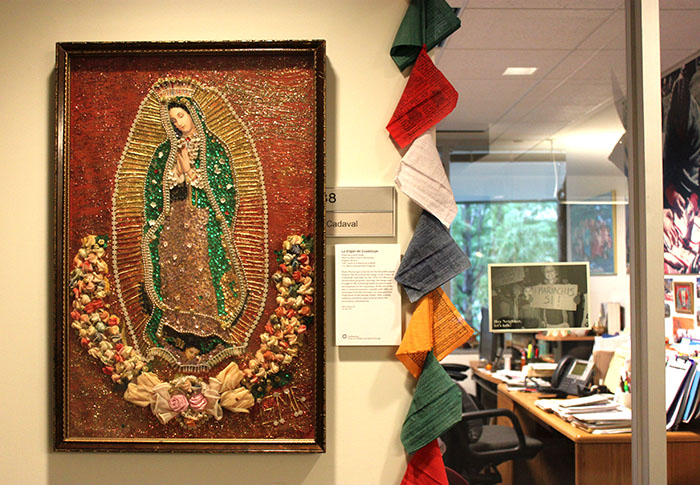The Virgin of Guadalupe has many names and stories. So, too, does the elaborately decorated version of la Virgen made by María Gloria Moroyoqui for the U.S.-Mexico Borderlands program at the 1993 Smithsonian Folklife Festival. Today she hangs outside the office of curator Olivia Cadaval, where she exerts a strong presence to all who pass her by.
The piece started out quite humbly as a commercial print of an image of the Virgin Mary found in the Basilica of Our Lady of Guadalupe in Mexico City. Only the face, hands, and angel holding her up remain visible from the print. The rest has been carefully embellished with sequins, crepe paper flowers, and strands of pearly beads, glitter, and gold cording to create the radiating sunrays around her.
Considered to be the dominant symbol of Mexican Catholicism, the visual attributes of the Virgin of Guadalupe are said to derive from a sixteenth century apparition of the young Virgin Mary near Mexico City. In one version of the story, a young girl appeared before Juan Diego, asking him to build a church in her honor at the place they were standing. When he returned to ask for a sign of her identity, she sent him to gather flowers from a nearby hillside, even though it was winter and the area should have been barren. Instead, he found Spanish roses in bloom, which he gathered and brought back to her. She arranged them in his cloak, and when he opened his arms to show the Bishop, the flowers fell to the floor, revealing an image of the Virgin of Guadalupe on the cloth.

Gloria Moroyoqui created her version of the Virgin prior to coming to Washington, D.C. Of mixed Yaqui and Mexican descent, she had journeyed from Nogales, Mexico, to participate in the Festival. She was invited as a food specialist, piñata and flower maker, and herbalist. A picture of her paper flowers was the poster image for the Festival that year. Moroyoqui made the framed image to be part of the décor in her stall, and then planned to present it as a gift to the Center.
However, there is much more to this wonderful piece than meets the eye.
During Festival time, the staff moves into several trailers adjacent to the Festival grounds on the National Mall. These become temporary office and staging places, as well as storage units for tools, supplies, and crafts. The Borderlands trailer was the setting for the beginning of the Virgin’s Washington story.
The Virgin needed special treatment from the moment she arrived, and facilitating that care became a part of Olivia’s daily routine. She recalls:
“When Gloria first brought the Virgin down to the Mall, she says, ‘Olivia, we need to bring the Virgin down to the Festival. We can’t leave her back there in the Festival trailer. She’ll get lonely…’ It was 9 a.m. on opening day and everyone was going crazy. But she was insistent. She said, ‘We need to take the Virgin to my stall so she can be there with me, but we’re not going to take her out just like that.’”
The Virgin needed music and a procession. So Olivia had to find a musician—not an easy task at 9 o’clock in the morning!
Somehow she managed. Later that day, Olivia discovered that the Virgin also needed a musical escort back to the trailer. And so it went.

“Every day of the Festival I had to go find a musician,” Olivia says. “One day the Yaquis would be playing, and another day the conjunto musicians. One time even Blaine Juan, the Tohono O’Odham participant, accompanied us. It was always very important. The Virgin was very much a part of that Festival. Every day she had to come out and be brought back in. After a while, people knew about the processions and would come to watch.”
Thus did the Virgin of Guadalupe take on an unexpected role of community building at the Festival. Today, she remains imbued with special meaning for those who remember the event or, now, learn her story.
Erin Younger is a research associate working on the material culture collection at the Center. Each day in the office brings a new moment of discovery, and she looks forward to sharing more of the object stories as she learns them.


